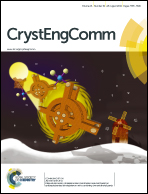Synthesis, structure, and piezoelectric properties of ferroelectric and antiferroelectric NaNbO3 nanostructures†
Abstract
NaNbO3 cubes and nanowires have been synthesized by a hydrothermal-based method utilizing thin Nb foil and low-concentration NaOH solution with the presence of H2O2. The Na2Nb2O6·H2O precursor can be obtained under hydrothermal conditions at 200 °C for only 4 h. Both long-time hydrothermal treatment and calcination on the precursor nanowires can realize the transition from Na2Nb2O6·H2O nanowires to NaNbO3 crystalline particles. However, the crystalline phases of the two products are different. NaNbO3 microcubes obtained by long-time hydrothermal treatment are in the antiferroelectric phase with space group Pbma, while NaNbO3 nanowires obtained by annealing Na2Nb2O6·H2O at 500 °C for 3 h are in the ferroelectric phase with space group P21ma. The experimental results from X-ray diffraction (XRD), field emission scanning electron microscopy (FESEM), high resolution electron microscopy (HRTEM) and Raman spectroscopy proved the difference between the crystalline phases of NaNbO3 microcubes and nanowires. Piezoelectric force microscopy (PFM) analysis proved that NaNbO3 nanowires exhibit piezoelectricity, while no piezoelectric response can be detected for NaNbO3 microcubes synthesized by direct hydrothermal treatment.


 Please wait while we load your content...
Please wait while we load your content...